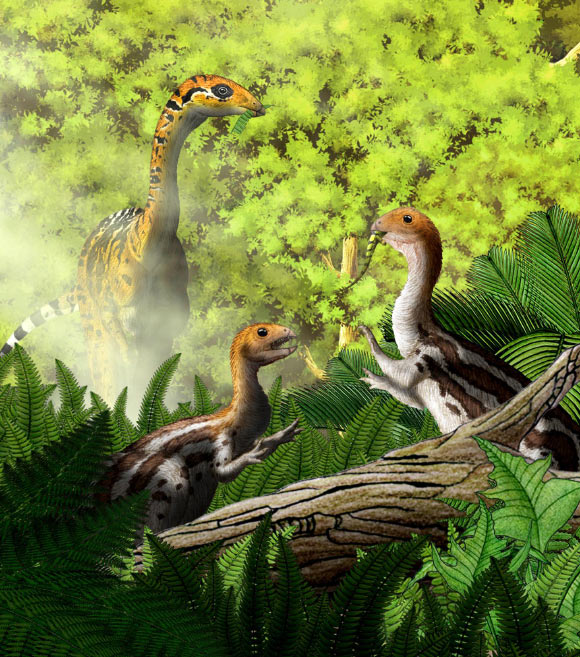An international team of paleontologists has discovered that Limusaurus inextricabilis, a species of Jurassic dinosaur, lost its teeth in adolescence and did not grow another set as adults.

Limusaurus inextricabilis is the only known reptile to lose its teeth and form a beak after birth. Image credit: Yu Chen.
Limusaurus inextricabilis (‘mire lizard who could not escape’) is a ceratosaurian theropod dinosaur that lived during the Upper Jurassic (Oxfordian) in what is now northwestern China. It was found in 159 million-year-old deposits located in the Junggar Basin of Xinjiang and earned its name from the way its skeletons were preserved, stacked on top of each other in fossilized mire pits.
The research team, led by Dr. Xing Xu from the Institute of Vertebrate Paleontology and Paleoanthropology in Beijing and Dr. Shuo Wang of Capital Normal University in Beijing, studied 19 skeletons of Limusaurus inextricabilis.
The individuals ranged in age from baby to adult, showing the pattern of tooth loss over time. The baby skeleton had small, sharp teeth, and the adult skeletons were consistently toothless.
“We analyzed 19 specimens of Limusaurus inextricabilis, representing six ontogenetic stages based on body size and histological data,” the authors explained.
“Among 78 ontogenetic changes we identified in these specimens, the most unexpected one is the change from fully toothed jaws in the hatchling and juvenile individuals to a completely toothless beaked jaw in the more mature individuals, representing the first fossil record of ontogenetic edentulism among the jawed vertebrates.”
“This discovery is important for two reasons,” said co-author Prof. James Clark, from the George Washington University’s Columbian College of Arts and Sciences.
“First, it’s very rare to find a growth series from baby to adult dinosaurs. Second, this unusually dramatic change in anatomy suggests there was a big shift in Limusaurus’ diet from adolescence to adulthood.”
“For most dinosaur species we have few specimens and a very incomplete understanding of their developmental biology,” said co-author Josef Stiegler, a graduate student at George Washington University.
“The large sample size of Limusaurus inextricabilis allowed us to use several lines of evidence including the morphology, microstructure and stable isotopic composition of the fossil bones to understand developmental and dietary changes in this animal.”
Limusaurus inextricabilis is part of the theropod group of dinosaurs, the evolutionary ancestors of birds.
The team’s earlier research of Limusaurus inextricabilis described the species’ hand development and notes that the dinosaur’s reduced first finger may have been transitional and that later theropods lost the first and fifth fingers. Similarly, bird hands consist of the equivalent of a human’s second, third and fourth fingers.
The fossils indicate that baby Limusaurus inextricabilis could have been carnivores or omnivores while the adults were herbivores, as they would have needed teeth to chew meat but not plants. The fossils also could help to show how theropods such as birds lost their teeth, initially through changes during their development from babies to adults.
“Tooth loss isn’t so unusual in animals alive today. There are fish and an amphibian that lose teeth as they grow. Platypuses lose their teeth too,” Dr. Wang said.
“But the discovery is still a first for the fossil record and for reptiles.”
The team’s findings, published in the journal Current Biology, suggest that the dietary habits and needs of some dinosaurs changed over the course of their development, most likely along with shifts in their digestive systems.
_____
Shuo Wang et al. Extreme Ontogenetic Changes in a Ceratosaurian Theropod. Current Biology, publihsed online December 22, 2016; doi: 10.1016/j.cub.2016.10.043







